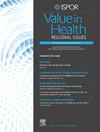The Burden of Alzheimer’s Disease and Its Costs to a Healthcare System in a Large Population in Brazil
IF 1.5
Q3 HEALTH CARE SCIENCES & SERVICES
引用次数: 0
Abstract
Objectives
In Brazil, cases of Alzheimer's disease (AD) are particularly prevalent in the southeastern region, including Minas Gerais, the largest state in the area. This study aimed to estimate the disease burden and healthcare costs from 2018 to 2022.
Methods
Data on life expectancy, human development index, population size, and gross domestic product per capita were extracted to calculate disability-adjusted life-years (DALYs). Hospital admission data for AD were obtained from the Brazilian Unified Health System Department of Informatics (DATASUS) database, including the number of cases, deaths, age-specific data, and treatment costs. These variables, along with health, social, and environmental data, were processed to create risk factor layers, and the mean cost per DALY was calculated. Generalized estimating equation models were used to analyze the relationship between DALYs and various predictors, controlling for spatial autocorrelation. Maps were created to visualize the distribution of DALYs and cost per DALY.
Results
There were 323 221 deaths from AD in Brazil, with cities averaging 3.61 deaths (range 1-73) and 5.43 hospitalizations (range 1-91) annually. The mean cost per city over these years was $9935.87 (range $44.22 to $787 307.93). In Minas Gerais, significant predictors of the estimated burden of AD include the percentage of the population aged 65 years and older, the human development index, and the prevalence of cardiovascular diseases. DALYs were higher than observed, indicating potential underreporting and insufficient resource allocation for AD treatment and prevention.
Conclusions
These results emphasize the need for region-specific policies and strategies to address the AD burden effectively. Policy makers should use this information to improve planning and allocate resources appropriately for treatment and prevention.
阿尔茨海默病的负担及其对巴西大量人口的医疗保健系统的成本。
目的:在巴西,阿尔茨海默病(AD)病例在东南部地区特别普遍,包括该地区最大的州米纳斯吉拉斯州。本研究旨在估计2018年至2022年的疾病负担和医疗费用。方法:提取预期寿命、人类发展指数、人口规模和人均国内生产总值等数据,计算伤残调整生命年(DALYs)。阿尔茨海默病的住院数据来自巴西统一卫生系统信息部(DATASUS)数据库,包括病例数、死亡人数、特定年龄数据和治疗费用。对这些变量以及健康、社会和环境数据进行处理,形成风险因素层,并计算每个DALY的平均成本。采用广义估计方程模型分析DALYs与各种预测因子之间的关系,控制空间自相关。我们制作了图表来可视化DALY的分布和每个DALY的成本。结果:巴西有323221例AD死亡,城市平均每年有3.61例死亡(范围1-73),5.43例住院(范围1-91)。这些年来,每个城市的平均成本为9935.87美元(44.22美元至787 307.93美元)。在米纳斯吉拉斯州,阿尔茨海默病估计负担的重要预测指标包括65岁及以上人口的百分比、人类发展指数和心血管疾病的患病率。DALYs高于观察值,表明潜在的低报和用于AD治疗和预防的资源分配不足。结论:这些结果强调需要制定针对特定区域的政策和战略来有效解决AD负担。决策者应该利用这些信息来改进规划,并适当地为治疗和预防分配资源。
本文章由计算机程序翻译,如有差异,请以英文原文为准。
求助全文
约1分钟内获得全文
求助全文
来源期刊

Value in health regional issues
Pharmacology, Toxicology and Pharmaceutics-Pharmacology, Toxicology and Pharmaceutics (miscellaneous)
CiteScore
2.60
自引率
5.00%
发文量
127
 求助内容:
求助内容: 应助结果提醒方式:
应助结果提醒方式:


